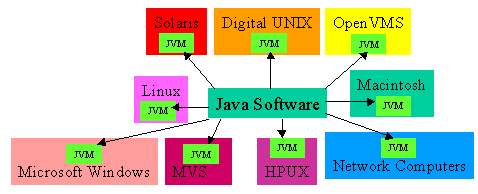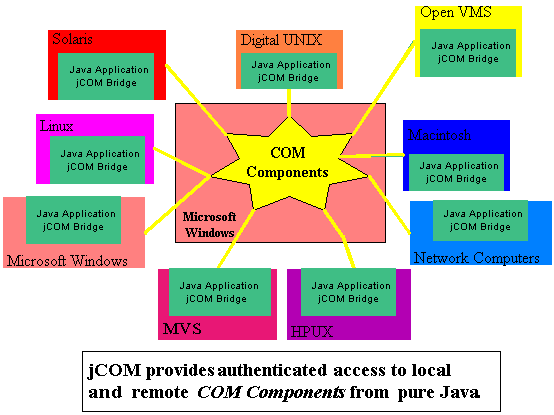


|

|
|
|
|
| | | |
Introducing BEA WebLogic jCOM
The following sections describe how WebLogic jCOM can expand the accessibility of WebLogic Server to COM clients:
What is BEA WebLogic jCOM?
BEA WebLogic jCOM is a bi-directional COM-Java bridging tool. Using WebLogic jCOM you can access Component Object Model (COM) components as though they were Java objects, and you can access pure Java objects as though they were COM Components.
The Java COM Conflict
In Support of Java
One of the reasons why so many companies are using Java, is that it allows them to dramatically reduce the costs of software development and deployment, because Java programs can execute on any platform that supports a standard Java Virtual Machine (JVM).

The principle of developing "pure" Java software is a very important one, and many software developers are, correctly, extremely concerned about the use of any software which locks them into a specific platform.
In Support of COM
Software Components are a natural evolution of Object Oriented software development, enabling the isolation of parts of an application into separate components. Such components can be shared between applications, and since components are only accessed through a rigidly defined interface, their implementation can be changed without impacting applications which use them.
Microsoft's widely used Component Object Model (COM) defines a binary standard for component integration, allowing COM components created using Visual BASIC (for example), to be accessed from an application created using Visual C++.
An enormous number of COM Components have been created and are available for purchase. Indeed, any software which has been recently developed under Microsoft Windows will almost certainly have been created using components.

Modern software design under Microsoft Windows practically mandates that an application be designed using a COM Component based approach. One of the benefits of doing so is that parts of an application's functionality can be made accessible to other applications, not only the same host, but also remotely -- using Distributed COM (DCOM).
The Conflict Between Java and COM
There may be conflict between the desire to create Java software which runs anywhere, and the need to re-use COM software components.
This conflict often manifests itself in companies where there are two clearly divided camps -- the Java developers, who abhor anything which will limit their pure Java software to a specific platform, and the Windows developers, that are urging the use and re-use of COM components.
Nevertheless, there is frequently a business need to access existing applications from new applications developed in pure Java, running in a standard JVM. Many of these existing applications were developed under Microsoft Windows, and because they were well designed, they expose their functionality to other applications by exposing COM Components.
WebLogic jCOM's Solution to the Conflict
BEA WebLogic jCOM offers a solution to the conflict by providing a bridge which allows you the "write once, run anywhere" benefit Java and the benefit of COM component re-use provides.

Internally WebLogic jCOM uses a standard platform independent mechanism which Microsoft has defined for accessing COM Components.
How WebLogic jCOM Works
WebLogic jCOM's Java-COM bridging capabilities allow COM access from and to Java objects that are running on any operating system environment.
COM developers can make callbacks into Java objects. WebLogic jCOM dynamically "remote-enables" any Java object, making all of its public methods and member variables accessible from COM.
To the Java programmer, WebLogic jCOM makes COM components look just like Java objects, presenting COM properties, methods and events as Java properties, methods and events.

Figure 1-1 WebLogic jCOM works with any Java Virtual Machine, on any platform, and requires no native code.
WebLogic jCOM's pure Java runtime talks to COM components using Distributed COM layered over Remote Procedure Calls (RPC), which are themselves layered on TCP/IP. So at the lowest level WebLogic jCOM uses the totally standard Java networking classes.
WebLogic jCOM Features
The key features of WebLogic jCOM can be summarized as follows:
|
|
|
|
|
|
|
Copyright © 2001 BEA Systems, Inc. All rights reserved.
|